Chapter 12: Corporate governance
Chapter learning objectives
Upon completion of this chapter you will be able to:
- explain the meaning of corporate governance
- recognise the extra-legal codes of corporate governance
- identify and explain the legal regulation of corporate governance.
1 Introduction
Definition
 Corporate governance can be defined as the system by which companiesare directed and controlled. (Corporate governance attracted manydifferent definitions and interpretations. The definition given above isjust one of them).
Corporate governance can be defined as the system by which companiesare directed and controlled. (Corporate governance attracted manydifferent definitions and interpretations. The definition given above isjust one of them).
It covers topics such as:
- how power is divided between the board and the shareholders
- the accountability of the board to the members of the company and other stakeholders
- the rules and procedures for making decisions.
Corporate governance provides the structure through which thecompany's objectives are met, the means of attaining those objectivesand monitoring performance.
Interaction of ethics, governance and company law
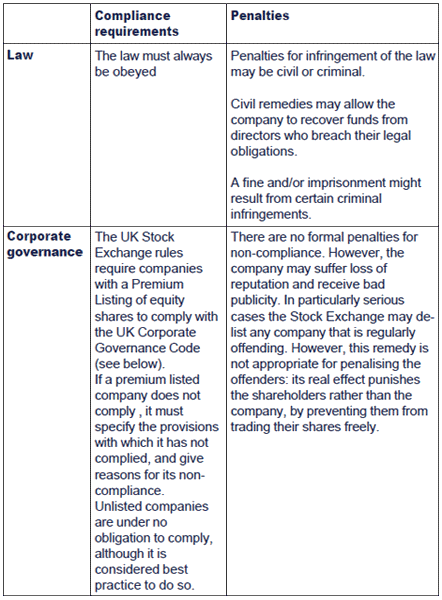
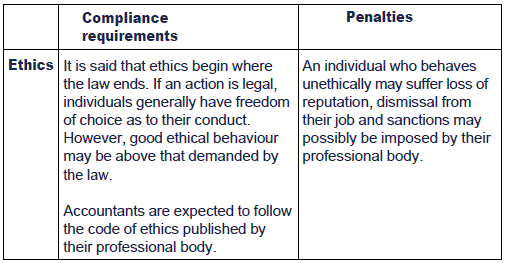
The need for corporate governance
During the late 1980s a number of large UK public companies failed,some of them as a result of large-scale fraud by their directors.
These failures reduced public confidence in financial reporting andauditing. Many people believed that company directors regardedaccounting standards as a set of rules to be circumvented and 'creativeaccounting' was implicated in several company liquidations:
- Directors were pressurising auditors to accept the use of 'creative accounting' schemes. Also, auditors often received extra remunerations from the company for consultancy work. Disagreement with the directors in the audit process could result in their loss of additional income. This situation often compromised the auditors' independence.
- There was no clear framework for ensuring that directors reviewed internal controls in their companies.
- There was a perceived lack of accountability for excessive remuneration of directors'.
A need to strengthen the systems of corporate governance used by UKcompanies was perceived. This need led to the establishment of theCadbury Committee, which is considered in the next section.

 Test your understanding 1
Test your understanding 1
Which one of the following is correct?
AIt is a criminal offence for premium listed companies to fail to comply with the UK Corporate Governance Code.
BA premium listed company hascomplied with the UK Corporate Governance Code if it produces a reportexplaining why it has not complied with its recommendations.
CThe UK Corporate Governance Code has no status and may be ignored by all companies.
DA public company may be sued for breach of statutory duty if it fails to comply with the UK Corporate Govenance Code.

2 The Organisation for Economic Co-operation and Development (OECD) Principles of Corporate Governance
The OECD has set out principles of corporate governance thatcountries may use to develop their own standards of corporategovernance. These principles (which were revised in 2004) are asfollows:
- The corporate governance framework should promote transparent and efficient markets, be consistent with the rule of law and clearly articulate the division of responsibilities among different supervisory, regulatory and enforcement authorities.
- The corporate governance framework should protect and facilitate the exercise of shareholder's rights.
- The corporate governance framework should ensure the equitable treatment of all shareholders, including minority and foreign shareholders. All shareholders should have the opportunity to obtain effective redress for violation of their rights.
- The corporate governance framework should recognise the rights of stakeholders established by law or through mutual agreements, and encourage active co-operation between corporations and stakeholders in creating wealth, jobs, and the sustainability of financially sound enterprises.
- The corporate governance framework should ensure that timely and accurate disclosure is made on all material matters regarding the corporation, including the financial situation, performance, ownership and governance of the company.
You have learned in this book how UK law has incorporated someprinciples such as these. In the rest of this chapter, you will reviewthe corporate governance codes existing in the UK.
3 The history of corporate governance in the UK
The Cadbury Committee
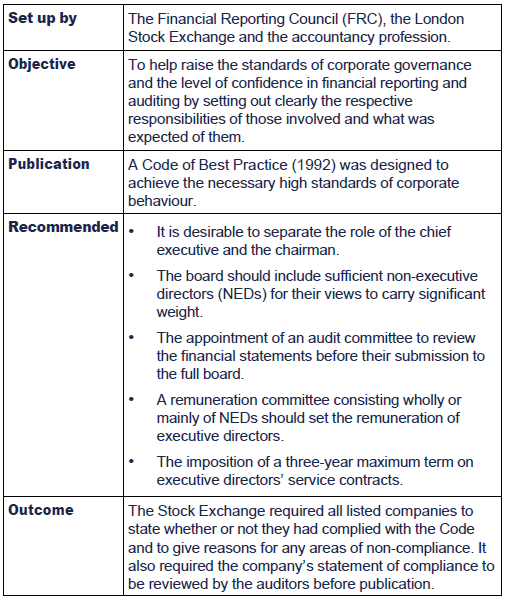

 The role of the NEDs
The role of the NEDs
At the time of the Cadbury Report, there was a history in the UK ofpublic companies being dominated by an all-powerful chiefexecutive/chairman. In addition, NEDs, where they existed at all, wereoften heavily outnumbered by executive directors and very rarely NEDswere truly independent of the company.
The Cadbury Report recommended the separation of the roles of thechief executive and the chairman, although it did not state that thesame person could never be both. The role of the chief executive is totake charge of the executive management and the company's businessoperations; the role of the chairman is to manage the board ofdirectors.
Cadbury recommended that there should be sufficient independentNEDs for their views to carry sufficient weight. As their independencemight be put at risk if they had to rely on the chairman or chiefexecutive for their appointment, Cadbury recommended that initialinterviews should be conducted through a nominations committee. Anindependent NED must be independent from the management and free fromany other business or relationship which could materially interfere withthe exercise of their independent judgment. (Cadbury Report, para 4.12)
The role of the NEDs is to bring judgement and experience to theboard that the executive directors might lack. In contrast to theexecutive directors, NEDs do not usually have a full-time relationshipwith the company. They are not employees and only receive directors'fees. They are expected to exert a measure of control over the executivedirectors to ensure that they run the company in the company's bestinterests (rather than their own). They should scrutinise theperformance of management in meeting agreed goals and objectives andmonitor the reporting of performance.
NEDs are also responsible for determining appropriate levels of remuneration for the executive directors.
Note that as far as company law is concerned, there is nodistinction between executive directors and NEDs. Both are subject tothe same controls and liabilities.

The Greenbury Report
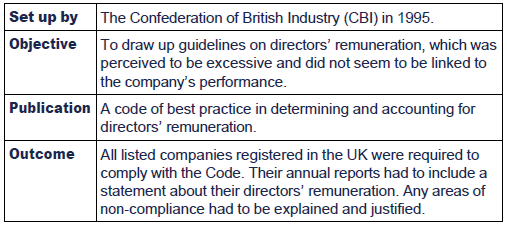
The Hampel Report
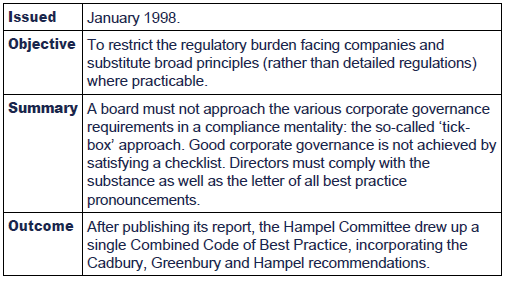
The 1998 Combined Code

The Turnbull Report
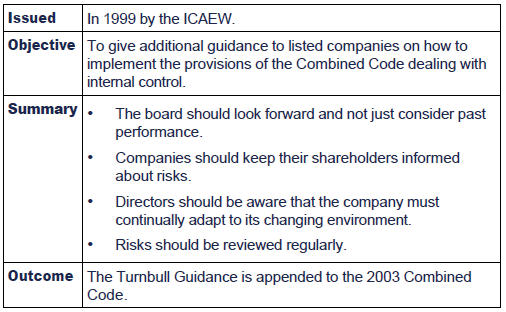
The Higgs Report

The Smith Report


 Test your understanding 2
Test your understanding 2
ADefine the term 'corporate governance'. (Your answer must not exceed 15 words.)
BState three of the recommendations of the Cadbury Report.
CWhich report in the UK drew up guidelines on directors' remuneration?
DComplete the following sentence in no more than 20 words:
The UK Stock Exchange rules require premium listed companies tocomply with the UK Corporate Governance Code. If it does not comply, thecompany must…

4 The UK Combined Code on Corporate Governance
History
The Combined Code on Corporate Governance was first issued in 1998. It consisted of principles and provisions (best practice).
Revised versions of the Code were issued in 2003, 2006 and 2008.The Code consisted of main principles, supporting principles andprovisions (practical requirements).
The Code was reviewed in March 2009 by the Financial ReportingCouncil with a consultation period and the revised Code was published inMay 2010 (see below).
5 The UK Corporate Governance Code
The Code applies to financial years beginning on or after 29 June 2010.
Contents
The Code consists of main principles, supporting principles and provisions (practical requirements).
Contents
The Code is divided into four sections:
- Section A - Leadership.
- Section B - Effectivenes.
- Section C - Accountability.
- Section D - Remuneration.
- Section E - Relations with Shareholders.
The main principles of each section are outlined below, together with some of the supporting principles.
Leadership
(1)Every company should be headedby an effective board, which is collectively responsible for thelong-term success of the company.
(2)There should be a clear divisionof responsibilities at the head of the company between the running ofthe board and the executive responsibility for the running of thecompany's business. No one individual should have unfettered powers ofdecision.
The supporting criteria indicate that this main principle should be met by splitting the roles of chairman and chief executive:
- the chairman should be responsible for the working of the board and the agenda for board meetings
- the chief executive should have full operational control and authority to carry out the policies determined by the board.
(3)The chairman is responsible for leadership of the board and ensuring its effectiveness on all aspects of its role.
(4)As part of their role as membersof a unitary board, non-executive directors should constructivelychallenge and help develop proposals on strategy.
Effectiveness
(1)The board and its committeesshould have the appropriate balance of skills, experience, independenceand knowledge of the company to enable them to discharge theirrespective duties and responsibilities effectively. The Codeprovides that the board should include a balance of executive and NEDs(and in particular independent NEDs), such that no individual or smallgroup of individuals can dominate the board's decision taking.
(2)There should be a formal, rigorous and transparent procedure for the appointment of new directors to the board.
(3)All directors should be able to allocate sufficient time to the company to discharge their responsibilities effectively.
(4)All directors should receive induction on joining the board and should regularly update and refresh their skills and knowledge.
(5)The board should be supplied in atimely manner with information in a form and of a quality appropriateto enable it to discharge its duties.
(6)The board should undertake aformal and rigorous annual evaluation of its own performance and that ofits committees and individual directors.
(7)All directors should be submitted for re-election at regular intervals, subject to continued satisfactory performance.
Accountability
(1)The board should present a balanced and understandable assessment of the company's position and prospects.
(2)The board is responsible fordetermining the nature and extent of the significant risks it is willingto take in achieving its strategic objectives. The board shouldmaintain sound risk management and internal control systems.
(3)The board should establishformal and transparent arrangements for considering how they shouldapply the corporate reporting and risk management and internal controlprinciples and for maintaining an appropriate relationship with thecompany's auditor.
The Code provides that the board should establish an auditcommittee of at least three (or in the case of smaller companies two)members, who should all be independent non-executive directors. Theboard should satisfy itself that at least one member of the auditcommittee has recent and relevant financial experience.
The main role and responsibilities of the audit committee should be set out in written terms of reference and should include:
- monitoring the integrity of the financial statements of the company
- reviewing the company's internal financial controls and risk management systems
- monitoring and reviewing the effectiveness of the company's internal audit function
- making recommendations in relation to the appointment, re-appointment and removal of the external auditor
- reviewing and monitoring the external auditor's independence and objectivity and the effectiveness of the audit process
- developing and implementing policy on the engagement of the external auditor to supply non-audit services.
Remuneration
(1)Levels of remuneration should besufficient to attract, retain and motivate directors of the qualityrequired to run the company successfully, but a company should avoidpaying more than in necessary for this purpose. A significant proportionof executive directors' remuneration should be structured so as to linkrewards to corporate and individual performance.
(2)There should be a formal andtransparent procedure for developing policy on executive remunerationand for fixing the remuneration packages of individual directors. Nodirector should be involved in deciding his or her own remuneration.
The Code provides that service contracts and notice periods should not exceed one year.
Relations with shareholders
(1)There should be a dialogue withshareholders based on the mutual understanding of objectives. The boardas a whole has responsibility for ensuring that a satisfactory dialoguewith shareholders takes place.
(2)The board should use the annual general meeting (AGM) to communicate with investors and to encourage their participation.
Rules-based verses principles-based approaches to governance
The UK Corporate Governance Code is a set of principles, ratherthan a set of rules. It requires directors to describe in their ownwords the way in which they have applied the general principles ofcorporate governance.
A principles-based approach to governance has the following advantages and disadvantages:
Advantages
- Because the directors report on the actual circumstances of their own company, the report should be more meaningful than one based on specific detailed requirements.
- A code of practice can be changed much more easily than statutory requirements. This means that the Code can be updated to respond to changing conditions and changing expectations of shareholders and others.
- A principles-based approach encourages the directors to follow the spirit of the Code, whereas a rules-based approach may result in a tick-boxes mentality. This means that under a rules-based approach the directors may follow the letter of the rules, rather than their spirit.
Disadvantages
- A principles-based approach tends to result in general, meaningless statements.
- It may be difficult for the directors to see whether they have met the specific requirements of the Code.

 Test your understanding 3
Test your understanding 3
AWhich three reports were combined to create the UK 1998 Combined Code?
BComplete the gaps. The following persons cannot be regarded as independent:
- anyone who has been an employee of the company in the previous …… years
- anyone who has had a material business relationship with the company in the previous …… years
- anyone who has served on the board for more than ……years.

6 The legal regulation of corporate governance
Introduction
The UK legislation covering corporate governance has been coveredin earlier chapters. The following table gives you an indication ofwhere to find the relevant provisions and gives you a description ofwhat they are:

The Sarbanes-Oxley Act 2002
The Sarbanes-Oxley Act 2002 is a US law that applies to allcompanies (including foreign companies) that have a listing on the USstock exchange.
It was introduced in the wake of corporate scandals such as the unexpected collapse of Enron and WorldCom.
The US approach to corporate governance is statutory rules-basedone. This differs from the approach taken in the UK, which isprinciples-based with an emphasis on voluntary compliance. TheSarbanes-Oxley Act requires all companies with a listing in the US toinclude in their annual report a certificate vouching for the accuracyof the financial statements. This certificate must be signed by thecompany's principal executive officer and principal financial officer.

 Test your understanding 4
Test your understanding 4
A What is the maximum permitted length of a director's service contract according to:
Ithe Companies Act 2006?
II the Cadbury Report?
IIIthe UK Corporate Governance Code?
BTo which companies does the Sarbanes-Oxley Act apply?

Chapter summary
Test your understanding answers

 Test your understanding 1
Test your understanding 1
B
The UK Corporate Governance Code is not legislation. It istherefore not mandatory. Companies are required to either comply withthe Code or explain why they have not done so. Therefore a company whichexplains why it has not complied with the Code's recommendations wouldnonetheless be complying with it!


 Test your understanding 2
Test your understanding 2
Corporate governance can be defined as the system by which companies are directed and controlled.
BAny three of the following:
- It is desirable to separate the role of chief executive and chairman.
- The board should include sufficient NEDs for their views to carry significant weight.
- The appointment of an audit committee to review the financial statements before their submission to the full board.
- A remuneration committee consisting wholly or mainly of NEDs should set the remuneration of executive directors.
- The imposition of a three-year maximum term on executive directors' service contracts.
CThe Greenbury Report.
DThe Stock Exchange rules requirelisted companies to comply with the Combined Code. If it does notcomply, the company must specify the provisions with which it has notcomplied, and give reasons for its non-compliance.


 Test your understanding 3
Test your understanding 3
ACadbury, Greenbury and Hampel.
BThe following individuals cannot be regarded as independent:
- anyone who has been an employee of the company in the previous five years
- anyone who has had a material business relationship with the company in the previous three years
- anyone who has served on the board for more than nine years.


 Test your understanding 4
Test your understanding 4
AThe maximum permitted length of a director's service contract is:
Itwo years according to CA 2006
II three years according to the Cadbury Report
IIIone year according to the UK Corporate Governance Code.
BThe Sarbanes-Oxley Act applies to all companies (including foreign companies) that have a listing on the US stock exchange.

|
Created at 5/24/2012 2:51 PM by System Account
(GMT) Greenwich Mean Time : Dublin, Edinburgh, Lisbon, London
|
Last modified at 5/25/2012 12:54 PM by System Account
(GMT) Greenwich Mean Time : Dublin, Edinburgh, Lisbon, London
|
|
|
|
 |
Rating
:
|
 Ratings & Comments
(Click the stars to rate the page) Ratings & Comments
(Click the stars to rate the page)
|
 |
Tags:
|
|
|
|
|